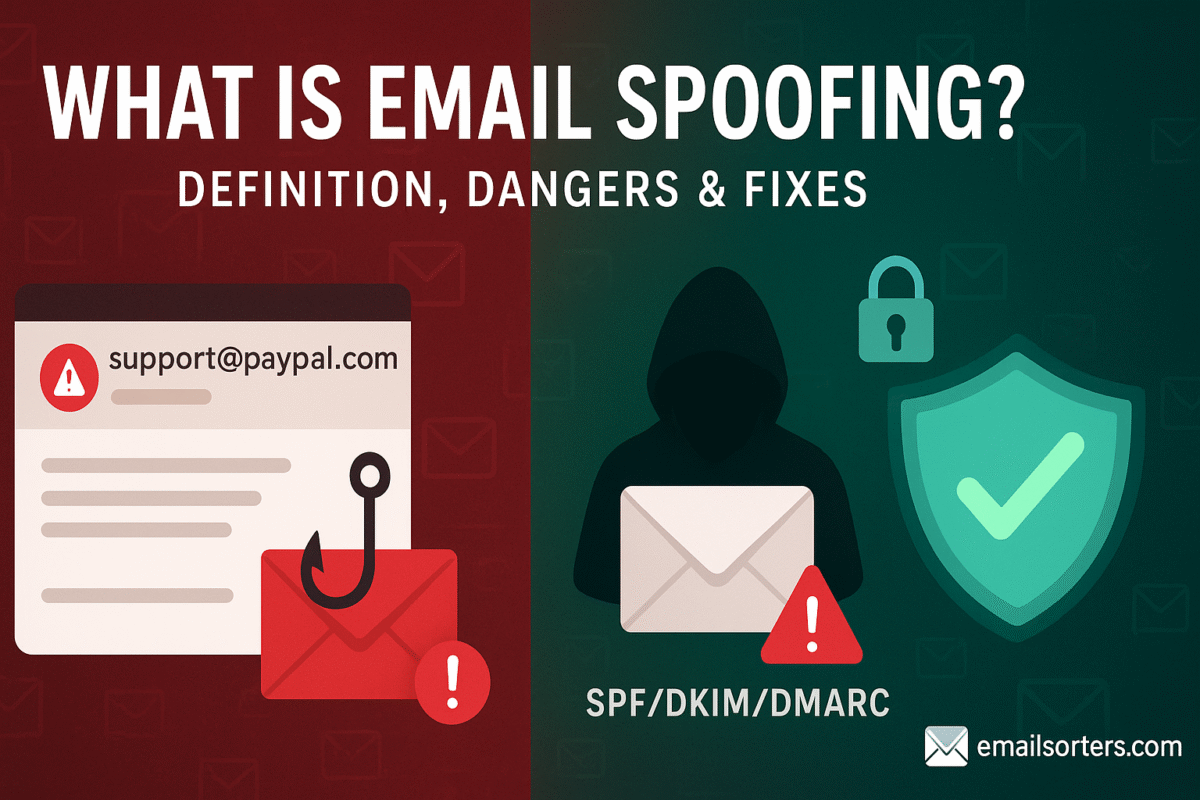Email spoofing is one of the most deceptive tactics used in cyberattacks today. It’s when someone fakes the “From” address in an email to make it look like it’s coming from someone else, usually someone you trust. Think of it as digital impersonation. Instead of showing who they really are, the sender manipulates their identity to appear legitimate, gaining access to your inbox or, worse, your trust.
Now, why is this such a big deal? Because emails are how we communicate with banks, coworkers, clients, vendors you name it. If someone can sneak a malicious email into your inbox and make it seem like it’s from your boss or your bank, they might just trick you into sending money, clicking a dangerous link, or giving up sensitive information. Spoofing isn’t always a standalone attack either. It’s often the setup for phishing, malware infections, ransomware, and financial fraud.
What makes spoofing especially sneaky is that it doesn’t always involve hacking into email accounts. Instead, attackers exploit weaknesses in the email system itself, mainly the Simple Mail Transfer Protocol (SMTP), which, unfortunately, doesn’t verify that the sender’s name matches their actual origin. This makes email spoofing surprisingly easy for cybercriminals to execute, especially when basic protections aren’t in place.
So in a nutshell: email spoofing is like a scammer wearing a mask of someone you know. It’s fake, dangerous, and far more common than you’d expect. And unless you know what to look for, you might not even realize it’s happening until it’s too late.
The Difference Between Spoofing and Phishing
A lot of people lump spoofing and phishing together, but while they’re often connected, they’re not the same thing. Let’s break it down.
Email spoofing is the act of faking an email’s sender address. That’s it. It’s all about impersonation. On the surface, the email looks like it came from someone trustworthy: a friend, your boss, your bank but it’s a trick.
Phishing, on the other hand, is the broader scam that the spoofing might be part of. Phishing involves tricking you into doing something by clicking a malicious link, downloading an infected attachment, or handing over login credentials or credit card info. Spoofing can be a tactic within a phishing campaign, used to gain the target’s trust.
You get an email from what looks like your IT department asking you to update your login credentials by clicking a link. If that email address is spoofed, and the link is actually a fake site, then you’ve been hit with both spoofing and phishing.
Here’s another way to think about it:
- Spoofing is the disguise.
- Phishing is the con.
How Email Spoofing Works – The Technical Breakdown
So how exactly do attackers spoof emails? The process is shockingly simple and relies on some old flaws in the way email is built.
The main issue lies in the Simple Mail Transfer Protocol (SMTP), the standard protocol used to send emails. SMTP doesn’t automatically check if the sender’s address is legitimate. That’s like sending a letter with a return address written in Sharpie. There’s no postal worker verifying if it’s real.
Here’s a quick step-by-step of how spoofing works:
- The attacker sets up an email server or script that sends out emails.
- They use software or tools (like Sendmail or SMTP libraries) to compose the message.
- They input any email address in the “From” field like support@yourbank.com or ceo@yourcompany.com.
- The email is sent. Unless your mail server uses specific validation checks (we’ll cover those later), it lands in your inbox looking legit.
Now, some email systems have checks in place like SPF (Sender Policy Framework), DKIM (DomainKeys Identified Mail), and DMARC (Domain-based Message Authentication, Reporting, and Conformance). But not everyone uses them. And even when they are in place, they’re not always configured properly.
Attackers often combine spoofing with:
- Social engineering: Writing believable messages that pressure the victim.
- Lookalike domains: Changing one letter in a domain name to fool users.
- Malware attachments or phishing links: To escalate the attack once trust is gained.
All of this is automated using tools like Metasploit, Emkei’s Mailer, or even Python scripts. It doesn’t take elite hacker skills to pull off email spoofing anymore, just a bit of know-how and the intent to deceive.
Common Tactics Used in Email Spoofing
Forging Sender Addresses
At the heart of every spoofing attack is a forged sender address. It’s like a fake ID for emails. By manipulating the “From” field in the email header, attackers make it appear that the email is coming from a trusted source.
Let’s say your bank’s real email is support@banksecure.com. A spoofed email might show that exact address even though the actual message is coming from a random IP address in another country.
How do they do it?
Using basic SMTP tools, attackers manually type whatever sender address they want. No password is needed for this part. Unless your email server requires authentication and has SPF/DKIM/DMARC rules in place, it won’t even question the origin.
There are two main types of forged addresses:
- Exact impersonation: They copy the full address of a real contact (e.g., ceo@company.com).
- Lookalike addresses: They use slight changes to trick the eye (e.g., ceo@cornpany.com).
What’s scary is how real these emails look. With the right branding, logos, and language, they can mirror legitimate emails so well that even savvy users get fooled.
But here’s the catch: when you hit “Reply,” the response may go to a different address or it might still route back to the real sender. It all depends on how deep the attacker went into crafting the spoof.
Header Manipulation Techniques
Header manipulation is one of the core strategies behind email spoofing and it’s a technical trick that works like a magician switching cards in a deck. Every email you receive carries hidden metadata, known as headers, that contain essential routing information such as the sender, recipient, IP address, servers used, timestamps, and more. Spoofers exploit this system by altering key components to mislead both you and your email client.
Here’s what gets tampered with most often:
- “From” Header: This is the most visible part to recipients and the easiest to fake. It shows who the email is “from,” and spoofers can input whatever they want here.
- “Reply-To” Header: Even if the “From” address looks legit, the reply-to might point to an attacker’s email address so when you respond, it goes directly to them.
- “Return-Path” Header: This tells receiving servers where bounce-back messages should be sent. Spoofers often use a fake one here to avoid detection.
Now, email clients like Gmail or Outlook often hide full headers by default, making it difficult for users to detect foul play unless they view the message source. This works in the attacker’s favor.
Why is this effective? Because most users don’t read headers. They see a familiar name and click without hesitation. And if the spoofed message mimics corporate formatting like using a company logo, footer, and tone it becomes even more convincing.
A common trick: inserting encoded or invisible characters that bypass keyword filters or spam detection systems. Some spoofers even adjust time stamps and subject line markers to match internal emails.
Payload Delivery – Malware, Links, and Requests
Let’s talk about the real payload, the nasty surprise at the end of a spoofed email. Spoofing on its own doesn’t cause damage. It’s just the setup. The real danger comes from what the email is trying to make you do.
Here are the most common payloads used in spoofing attacks:
1. Malicious Attachments
Spoofed emails may carry what look like harmless PDF files, Excel sheets, or Word documents. But once opened, these attachments deploy:
- Ransomware that locks your files until you pay.
- Keyloggers that steal passwords.
- Trojans that give hackers remote access to your system.
They often exploit macros or hidden scripts to infect your machine. Even antivirus software can miss them if the malware is new or cleverly disguised.
2. Phishing Links
Another common trick is embedding fake login pages in a link. A spoofed email might say:
“Your account has been compromised. Please log in to verify your credentials.”
Clicking the link sends you to a site that looks just like your bank or Microsoft login page. You enter your username and password and just like that, the attackers have full access.
3. Fake Requests
This is huge in Business Email Compromise (BEC) schemes. The spoofed email asks you to:
- Transfer money to a vendor.
- Buy gift cards and send codes.
- Share employee tax forms or customer records.
These messages come with urgency, pretending to be from executives or external partners. They’re crafted to bypass logic by appealing to authority and deadlines.
The psychology of these attacks is just as important as the tech. Spoofers know how to use fear, trust, and confusion to manipulate people. That’s what makes their payloads so effective.
Business Email Compromise (BEC)
Business Email Compromise is one of the most profitable email-based scams in the world and spoofing is often the foundation of the attack. In BEC, attackers pose as executives, vendors, or partners to manipulate employees usually in finance or HR into wiring money, changing bank info, or leaking sensitive data.
The FBI reported that BEC scams have led to billions of dollars in losses globally. These are not sloppy spam messages. They are carefully researched and highly targeted, often using social engineering, publicly available information, and email spoofing to create trust.
Here’s how a typical BEC works:
- The attacker researches a company, identifies the CFO or accounting department.
- They spoof the CEO’s email and send a message like
“I’m traveling and can’t access our system. Please transfer $75,000 to this vendor today. I’ll follow up shortly.” - The employee sees a legit-looking email address and complies especially if the CEO’s tone and signature are accurate.
Sometimes, attackers even hijack real threads by spoofing both the sender and recipient, injecting themselves in the middle of conversations. This tactic is called man-in-the-email.
What makes BEC especially dangerous is its simplicity. It doesn’t require malware, brute-force hacking, or high-tech tools. Just a believable email and a moment of trust.
Companies can fight back with:
- Multi-person approval for financial actions.
- Internal education on email verification.
- Technical protections like DMARC, SPF, and DKIM.
CEO Fraud and Whaling Attacks
CEO fraud and whaling are specialized forms of email spoofing that target high-profile individuals usually C-suite executives or key personnel in financial departments. These attacks are called “whaling” because they go after the “big fish.”
Here’s how it typically plays out: the attacker spoofs the CEO or CFO’s email address and sends a request to an employee with financial authority. The email will usually be urgent, concise, and confidential. It might say something like:
“We’re finalizing an important acquisition. Please transfer $200,000 to this account today. Keep this confidential for now we’ll announce soon.”
The email might even reference real people, projects, or schedules the attacker found on LinkedIn, the company website, or press releases. This use of contextual knowledge makes the message incredibly convincing.
Why do these attacks work so well?
- Hierarchy pressure: Employees are often trained to act quickly on requests from senior executives.
- Timing: Many of these emails are sent on Fridays, before holidays, or late in the day when people are less likely to verify.
- Secrecy: Attackers stress confidentiality, which discourages victims from double-checking with colleagues.
What’s the damage? Millions. In one widely known case, a European manufacturing company lost over €40 million to CEO fraud through a spoofed email. The attacker had studied the company’s workflow, identified key decision-makers, and mimicked the CEO’s tone and language.
Preventing whaling attacks requires both technical defenses and cultural changes within companies. Leaders should create a culture where employees feel empowered to verify even urgent requests. Executives should also limit what sensitive business plans they share online.
Government and Institutional Targets
Spoofing attacks aren’t just a corporate issue, they’re a national security concern too. Cybercriminals and state-sponsored hackers have targeted government agencies, public institutions, universities, and even military departments using email spoofing.
These attacks aim to:
- Steal classified or sensitive information.
- Disrupt services or infrastructure.
- Damage credibility through misinformation.
- Deliver malware that compromises entire networks.
For example, in 2020, several spoofed emails were sent to government officials disguised as internal IT alerts. These emails contained links to malware that could steal login credentials, allowing attackers to infiltrate secure systems.
Universities and research institutions are also major targets. Spoofed emails pretending to be from grant agencies or department heads are used to steal research data, financial information, or login access.
These attacks are often more sophisticated, involving:
- Advanced social engineering: tailored messages based on publicly available data.
- Zero-day malware payloads: previously unknown viruses that evade detection.
- Multiple spoofed identities: attackers may mimic several individuals in one thread to simulate legitimacy.
To fight back, institutions must deploy robust email filtering, implement strict authentication protocols, and train staff to verify any unusual request no matter how legitimate it looks.
Why Email Spoofing Is Dangerous
Financial Losses and Fraudulent Transactions
Let’s be clear: email spoofing isn’t just annoying. It’s expensive. It costs businesses and individuals billions of dollars every year and most of it comes down to fraudulent transactions triggered by spoofed emails.
How does this happen?
- A spoofed vendor invoice email requests payment to a new bank account.
- A fake payroll update form is sent to HR, redirecting employee paychecks.
- An executive “authorizes” a large international transfer based on a spoofed message.
These aren’t isolated events. They happen every day across companies of all sizes. In fact, the FBI’s Internet Crime Complaint Center (IC3) regularly reports that Business Email Compromise alone accounts for the majority of financial cybercrime losses.
But it’s not just about the money. Recovering from a spoofing-based fraud often involves:
- Legal battles.
- Insurance claims.
- Compliance investigations.
- Damaged relationships with vendors or clients.
The worst part? In many cases, the victim has no legal recourse to recover the funds. Banks aren’t responsible for money sent voluntarily even if it was sent based on a spoofed email.
Prevention is the only cure. Businesses must implement layered approval systems, verify requests via a second communication channel (like a phone call), and continuously train staff to spot signs of spoofing.
Data Breaches and Identity Theft
Spoofed emails aren’t always about stealing money sometimes, they’re about stealing you. Cybercriminals use spoofing to trick people into giving away login credentials, social security numbers, tax forms, medical records, and more.
Once an attacker has this data, they can:
- Commit identity fraud.
- File fake tax returns.
- Open new credit accounts.
- Access private company databases.
- Launch further attacks on your colleagues or customers.
In one well-documented case, a spoofed email pretending to be from a company’s HR department asked employees to “update their W-2 forms.” Hundreds complied, handing over their tax and identity info straight to the attacker.
Another version? Spoofed IT emails requesting a password reset or MFA override. Victims think they’re helping support but they’re handing over the keys to their kingdom.
And it’s not just personal identity that’s at stake. Attackers can also:
- Exfiltrate trade secrets.
- Leak customer data.
- Compromise supply chains.
This can trigger massive data breaches, which may lead to:
- GDPR or HIPAA fines.
- Class-action lawsuits.
- Loss of customer trust.
Preventing these types of breaches means making email verification a core part of every organization’s cyber hygiene. Teach employees to question every request, especially those involving login credentials or personal info.
Reputational Damage to Organizations
Last but definitely not least, let’s talk about the silent killer in email spoofing attacks: reputation loss.
When customers or partners receive spoofed emails that appear to come from your domain, they don’t blame the hacker they blame you. Even if your systems weren’t technically breached, the perception of vulnerability can be just as damaging as an actual hack.
Some real-world consequences include:
- Customers unsubscribing due to security fears.
- Vendors refusing to work with a “risky” organization.
- Media coverage that destroys public trust.
- Investors pulling back due to perceived instability.
The impact can last for years. A single spoofing incident can trigger PR crises, social media backlash, and customer churn.
That’s why it’s critical for companies to protect their domain with SPF, DKIM, and DMARC protocols. These don’t stop spoofed emails entirely, but they help receiving servers reject unauthorized messages that appear to come from your domain.
It’s also wise to:
- Use brand monitoring tools to track impersonation attempts.
- Notify your users and partners when spoofing attacks are detected.
- Provide regular security updates and transparency.
Analyzing Email Headers
If you’re trying to figure out whether an email is spoofed, one of the first and most effective techniques is to analyze the email headers. While most people never look beyond the surface of an email, the header contains all the behind-the-scenes details like who really sent the message, what servers it passed through, and whether it passed any authentication checks.
Start by locating the option in your email client that allows you to “view original” or “show headers.” In Gmail, for example, you can click the three dots next to a message and select “Show Original.” Once opened, you’ll see a wall of technical text. But don’t worry there are a few key items to look for.
First, check the “Return-Path.” If the email claims to be from a domain like yourbank.com, but the return-path shows something random like zxcx334@weirdserver.org, that’s a red flag. Next, look at the “Received” fields, which show the servers the message traveled through. If the email claims to be from Microsoft but originated from an unknown IP or country, that’s another sign something’s off.
Another major component to check is the results of SPF, DKIM, and DMARC authentication. These are security checks that help verify whether an email is genuinely from the domain it claims to be. If you see “fail” next to any of these fields, that’s a solid indicator of spoofing.
The beauty of header analysis is that it’s not based on gut feelings it gives you technical proof. If something looks suspicious, the headers will often reveal the truth. However, interpreting headers requires a bit of learning. Fortunately, there are online header analysis tools where you can paste the raw header, and the tool will break it down for you in a more understandable format.
While this method might sound too techy for everyday users, in organizations, it’s essential for IT teams and cybersecurity personnel to be fluent in reading headers. It’s one of the best ways to catch spoofing attempts early and prevent a bigger breach from happening.
Recognizing Red Flags in Email Content
Even without digging into headers, there are plenty of signs within the email content itself that can help you identify a spoofed message. The trick is to slow down and pay attention to the small details because spoofers are counting on you to act quickly without thinking.
One of the most common red flags is urgency. Spoofed emails often try to create a false sense of emergency. They might say things like, “Your account will be suspended in 24 hours” or “Immediate action required to avoid penalties.” These messages are designed to push you into acting before you can think or verify.
Next, look at the tone and language of the message. If it’s from someone you know, does it sound like them? Are there grammar issues, weird phrasing, or spelling errors? Many spoofed emails are created by attackers for whom English is a second language, and while some are very polished, many are not. A message from your bank filled with typos? That’s a red flag.
The use of strange links is another giveaway. Hover your mouse over any link before clicking it. Does the URL match the sender’s domain? If the email claims to be from PayPal, but the link goes to “paypa1-account-login.ru,” it’s almost certainly spoofed. Some attackers even use link-shortening services to hide the final destination. That’s a tactic to avoid.
Spoofed emails might also include suspicious attachments, especially ones you weren’t expecting. If someone suddenly sends you a .zip file or a Word document asking you to enable macros, don’t touch it. That’s a common way malware spreads.
Spoofers may also use mismatched email addresses and names. You might see an email that says it’s from “Google Support” but the address is something random like “userservice1994@gmail.com.” Always check both the name and the actual address.
A spoofed email can even appear to come from your own address a tactic called “email spoofing loopback.” If you get a message from yourself that you didn’t send, it’s time to investigate.
All of these clues are breadcrumbs. When you follow them, they can lead you to the truth about whether an email is real or fake. Trust your instincts, verify everything, and never assume just because a message looks right that it is.
Using Email Security Tools and Services
When it comes to email spoofing, relying solely on human vigilance isn’t enough. The sophistication of modern spoofing attacks makes it necessary to bring in technological reinforcements. That’s where email security tools and services come into play; they act as your digital bodyguards, monitoring, filtering, and blocking suspicious messages before they reach your inbox.
At the organizational level, one of the best defenses is implementing email authentication protocols: SPF (Sender Policy Framework), DKIM (DomainKeys Identified Mail), and DMARC (Domain-based Message Authentication, Reporting & Conformance). These protocols work together to verify that incoming emails are genuinely from the domain they claim to be. SPF checks if the sending server is authorized to send mail for the domain. DKIM uses cryptographic signatures to confirm the message wasn’t altered. DMARC ties it all together and tells your email server how to handle failures whether to quarantine, reject, or accept the message.
For end-users, modern email clients like Gmail and Outlook incorporate AI-based spam filters that analyze behavior patterns, sender reputation, and historical data to flag suspicious emails. While not perfect, these systems catch a significant percentage of spoofed messages.
Beyond native tools, there are third-party security platforms like Proofpoint, Mimecast, and Barracuda. These services provide advanced filtering, threat detection, URL sandboxing, and even impersonation protection. They scan every attachment and link, simulate its execution in a secure environment, and block it if it shows any malicious behavior.
For personal users, browser extensions and antivirus suites also offer email protection features. These can include real-time link scanning, phishing site alerts, and encrypted email sending options.
Another tool worth mentioning is a domain monitoring service. These tools alert you if someone tries to send emails pretending to be from your domain or registers a similar domain name for impersonation purposes.
Conclusion
Email spoofing isn’t some niche cybersecurity concern it’s a widespread, evolving threat that affects individuals, businesses, and institutions around the world. It’s deceptive, it’s dangerous, and in many cases, it’s devastating. But the good news is that it’s also preventable.
By understanding what email spoofing is, how it works, and what red flags to watch for, you’re already several steps ahead of the average user. When you add technical protections like SPF, DKIM, and DMARC into the mix, plus smart employee training and modern security tools, you create a strong defense system.
Spoofers rely on one thing: your trust. Break that trust barrier with verification, skepticism, and smart practices, and their strategy falls apart.




